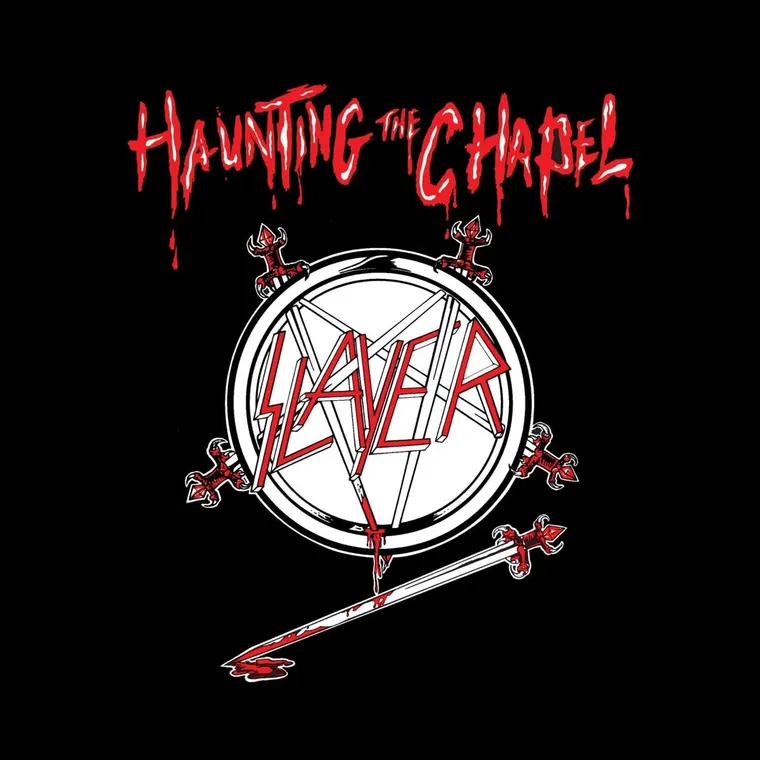Released on August 4, 1984, Haunting the Chapel is Slayer’s ignition spark—an EP that didn’t just hint at their future dominance but violently ripped open the door to it. It marked the moment Slayer transformed from promising speed metal upstarts into true pioneers of extreme thrash. Where Show No Mercy was raw and steeped in NWOBHM influence, Haunting the Chapel was faster, darker, and far more sinister. This wasn’t just a follow-up—it was a warning shot.
At its core, Haunting the Chapel is the sound of thrash metal mutating—shedding its leather-and-studs past for something far more aggressive and apocalyptic. Slayer started carving their path with surgical precision, introducing the chaotic solos, blasphemous themes, and unrelenting tempos that would define them—and later, much of extreme metal.
In an era when most metal bands were still leaning into melody or theatrics, Slayer brought cold, calculated violence to the genre. This EP wasn’t trying to be accessible—it was trying to be feared. And it succeeded.
Hellfire, Hooks, and the Rise of Speed: The Shift Begins
“Chemical Warfare” opens the EP like a flamethrower to the face. The riffs are unrelenting—sprinting forward with a precision that had yet to be heard in 1984. Dave Lombardo’s drumming sounds like it was recorded inside a warzone, while Araya’s vocal assault balances clarity and chaos. There’s no buildup—just immediate, all-out destruction.
“Captor of Sin” brings in an eerie, slow-burning intro before launching into one of Slayer’s most evil-sounding riffs. The dual guitar work of Kerry King and Jeff Hanneman feels frantic but never sloppy. The leads squeal like tortured souls, while the rhythm section crushes forward. It’s ritualistic, malevolent, and completely enthralling.
“Haunting the Chapel,” the title track, seals the deal. With its dissonant opening chords and anti-religious venom, it feels like the mission statement for what Slayer would become. Araya’s screams are commanding, and the song’s structure is tighter and more menacing than anything on their debut. The EP’s namesake track doesn’t just haunt—it condemns.
Riff Rituals and Rhythmic Violence: Slayer Tightens the Screws
While Haunting the Chapel clocks in at just over 17 minutes (21 minutes if your version includes Aggressive Perfector), it delivers more lasting impact than many full-lengths of the era. The production is raw but more controlled than Show No Mercy, capturing the fury without burying the precision. It feels like a violent basement demo—feral, yet focused.
This EP is also where Slayer’s thematic identity fully crystallized. The lyrics are no longer just evil for shock value—they're confrontational, deliberately blasphemous, and steeped in rage. Slayer wasn’t playing villains. They were the villains.
The real breakthrough, however, is Lombardo. His drumming on this EP sets a new bar for thrash. From blast beats to hyperactive fills, he injects an energy that is both unpredictable and utterly relentless. The speed, the precision, and the sheer violence of his performance make this release not just important—but foundational.
The Players Evolve: Precision and Presence
Tom Araya takes a step forward here as a full-fledged frontman. Gone are the semi-melodic lines of the debut—replaced with sharper, shouted proclamations of damnation. His bass is buried in the mix but his vocal dominance begins here.
Kerry King and Jeff Hanneman are the riff architects of the apocalypse. Their playing is chaotic by design, but on Haunting the Chapel, the chaos is controlled. The solos squeal and dive-bomb like possessed banshees, while the rhythm work is sharpened to a deadly edge.
Dave Lombardo is the MVP. His double-kick work, fills, and tempo shifts brought a new level of sophistication to thrash drumming. What we hear on this EP would eventually evolve into the rhythmic juggernaut of Reign in Blood, but the seeds were planted here.
Final Verdict: 8.5/10
Haunting the Chapel is not just a transitional Slayer release—it’s a cornerstone of thrash and extreme metal evolution. Raw, urgent, and unrepentantly evil, it pushed boundaries and set a new standard for speed, intensity, and atmosphere.
41 years later, the EP still snarls with the same unholy energy it did in 1984. It remains essential—not just for Slayer fans, but for anyone who wants to understand how metal became truly extreme. In just three songs, Slayer redefined what thrash could be—and set fire to everything that came before.
Slayer didn’t haunt the chapel. They desecrated it—and made metal heavier in the process.

